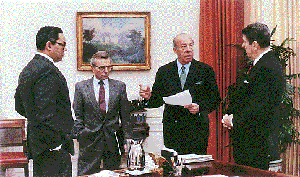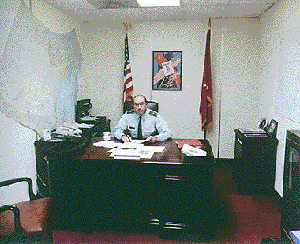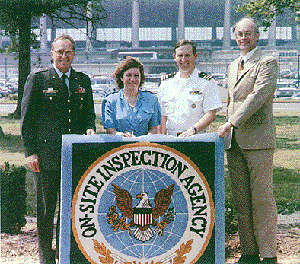 President Reagan (right) in the Oval Office with Secretary of State George P. Shultz, Secretary of Defense Frank C. Carlucci, and Lt. General Colin L. Powell, Assistant to the President for National Security Affairs. |
With this
decision in mid-December, the Reagan Administration had
resolved many of the organizational issues of how it
would carry out its INF Treaty obligations. First, as
stipulated in the INF Treaty, the Nuclear Risk Reduction
Center, located in the State Department, would channel
all official treaty-related communications between the
two nations. Next, a new On-Site Inspection organization,
affixed in the Defense Department, would manage and
conduct all American inspections and escort Soviet
inspectors for the duration of the Treaty. Third, U.S.
representation to the Special Verification Commission,
mandated by the INF Treaty to resolve compliance
questions, would be provided by a senior official
assigned administratively to the Arms Control and
Disarmament Agency. Finally, other U.S. Government
agencies would have the mission of providing and
analyzing information on INF Treaty compliance. Policy
questions concerning Soviet compliance and verification
on the treaty would be defined and discussed in the
National Security Council committees by representatives
of those departments and agencies--OSD, JCS, ACDA, State,
and other agencies--which oversaw all arms control
treaties. The President and his senior NSC advisors would
make the final decision. Still unresolved, however, were a host of practical issues: composition of inspection/escort teams, managerial concepts and policies for portal monitoring operations, use of commercial or military airlift, extent of financial resources, location of headquarters and field operating offices, organizational status within the Department of Defense, and even the new organization's name--On-Site Inspection Organization or On-Site Inspection Agency. For the next four weeks, mid-December to mid-January, General Daniel's small task force attacked these issues on a number of fronts. Rather quickly, they recommended that it be named an "agency" over "organization." The issue of Department of Defense separate agency status or subordination within an existing DOD agency was much tougher. It involved two major issues acutely present in the Reagan Administration in the 1980s. First, General Daniel and the senior officers in the Joint Chiefs of Staff perceived that the new "agency" had to be sufficiently independent to compete for resources--people, money, equipment--with other established organizations and agencies within the Department of Defense. If the new agency were subordinate to another Defense Department entity, like the Defense Nuclear Agency, then there was the possibility of confusion in the interagency and interservice arenas. Independence implied decisiveness; and decisiveness translated into a quickly-established, professional organization capable of representing the U.S. government with the Soviet government.4 |

